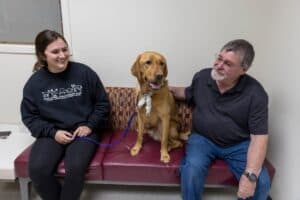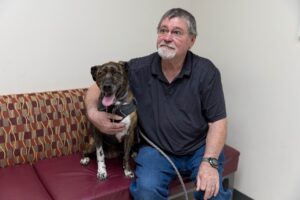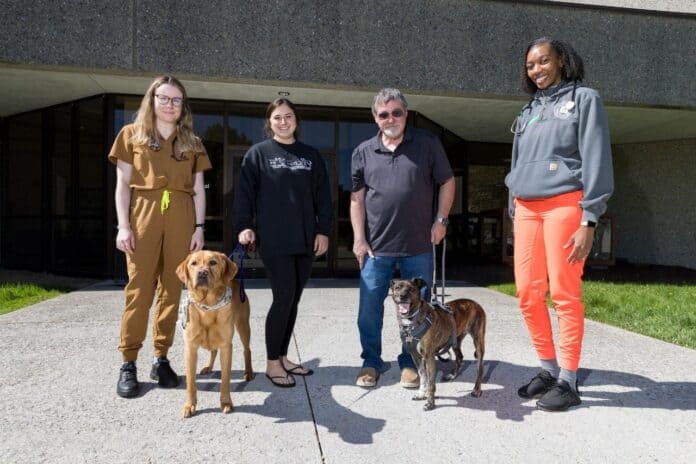Two dogs may have not fully understood the significance of meeting one another at the Veterinary Teaching Hospital, but their owners certainly did. With the gift of a blood donation, Indie saved Arya’s life.
Arya is the cocker spaniel-hound dog mix breed dog of Dale and Billie Stephens of Pulaski County. Stephens noticed Arya getting lethargic and took her to Dublin Animal Hospital, where tests found an extremely low platelet count.
“She was at the point of where she could hemorrhage to death,” Stephens said.
The teaching hospital at the Virginia-Maryland College of Veterinary Medicine at Virginia Tech was contacted and Arya was taken into the emergency room.
A call to action
“We were so distraught coming over here, thinking that we were going to have to put her down,” Stephens said. “Then come to find out, Indie came to the rescue, and now she’s living, and she’s doing better.”
Indie is the 3-year-old Labrador retriever of veterinary student Delaney Groves of Boones Mill. Indie was enrolled as a blood donor even before Groves, who earned a degree in animal and poultry sciences in 2023, was accepted into veterinary college.
Because Indie had not recently given a blood donation, he was a good choice to be a direct donor to Arya, and Groves was quick to respond when she received the call that her dog could help save the life of another.
“He comes in routinely,” Groves said. “But this was the first time that we have been called into an emergency donation because he was the only one that hadn’t donated recently. So it worked out pretty well because he was a match for Arya.”
“She brought her dog over that night, and they gave her [Indie] a live blood transfusion,” Stephens said. “I think if we hadn’t got that, she would have died.”
An unusual case
Arya’s diagnosis was indeed dire.
“She was bleeding in her digestive system, urinary system, and suspected into her brain,” said Alexandra Cleversley, a teaching hospital resident. “The immune system decides to attack the platelets, which can be primary, you don’t know the reason, or secondary to infection, cancer, inflammation, or a drug or toxin.”
The most efficient way for Arya’s condition to improve was a transfer of whole blood from a donor dog.
“This case was unusual because we have blood in the bank, and we keep blood products ready to go, but we can’t keep fresh whole blood ready to go,” said Melanie Gevedon, special procedures and blood bank veterinary technician. “This case was different because they had to bring the dog in and donate immediately and then give the blood immediately. And that’s because they needed platelets, which are damaged and lose function during cold storage.”
Groves didn’t hesitate when asked if she would bring in Indie for the blood donation to Arya.
“Having clients who want to do everything possible for their dogs makes it worthwhile,” Groves said. “Because you know how much their pets mean to them”


More blood donors needed
Gevedon said the teaching hospital currently has 16 dog blood donors and three cat blood donors, numbers she would like to see grow. The need is stronger for donor dogs because the teaching hospital does purchase some cat blood externally.
Dog blood donors must be between 1 and 8 years old, weigh 55 pounds or more, be in good health and reasonably well-behaved. They must be up to date on rabies, distemper and leptospirosis vaccines, willing to lie on a table for 10 minutes with handling and not be overly afraid of clippers used to shave a spot on the neck.
Each donor dog receives flea, tick, and heartworm prevention, exams, blood work, and vaccines that are due for free.
For more information on the Veterinary Teaching Hospital Blood Bank and possibly enrolling your pet, please visit the bank’s webpage.
By Kevin Myatt


